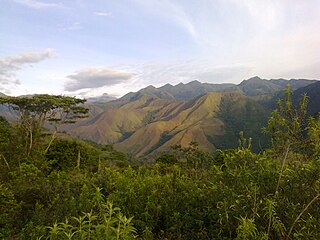
Zulia State is one of the 23 states of Venezuela. The state capital is Maracaibo. As of the 2011 census, it has a population of 3,704,404, the largest population among Venezuela's states. It is also one of the few states in Venezuela in which voseo is widespread. The state is coterminous with the eponymous region of Zulia.

Maracaibo is a city and municipality in northwestern Venezuela, on the western shore of the strait that connects Lake Maracaibo to the Gulf of Venezuela. It is the second-largest city in Venezuela, after the national capital, Caracas, and the capital of the state of Zulia. The population of the city is approximately 2,658,355 with the metropolitan area estimated at 5,278,448 as of 2010. Maracaibo is nicknamed "The Beloved Land of the Sun".
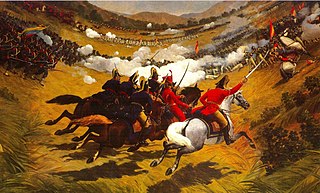
The Venezuelan War of Independence was one of the Spanish American wars of independence of the early nineteenth century, when independence movements in South America fought a civil war for secession and against unity of the Spanish Empire, emboldened by Spain's troubles in the Napoleonic Wars.
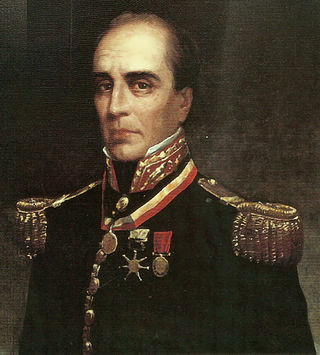
Rafael José Urdaneta y Farías was a Venezuelan General and hero of the Spanish American wars of independence. He served as President of Gran Colombia from 1830 until 1831. He was an ardent supporter of Simón Bolívar and one of his most trusted and loyal allies.

Municipalities of Venezuela are subdivisions of the States of Venezuela. There are 335 municipalities dividing the 23 states and the Capital District.

Carlos Raúl Villanueva Astoul was a Venezuelan modernist architect. Raised in Europe, Villanueva went for the first time to Venezuela when he was 28 years old. He was involved in the development and modernization of Caracas, Maracay and other cities across the country. Among his works are El Silencio Redevelopment which included 7797 apartments and 207 shop premises and the Ciudad Universitaria, the main campus of the Central University of Venezuela. The Campus was declared a World Heritage Site by UNESCO in the year 2000.
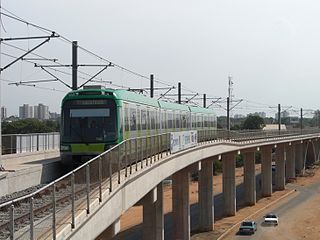
The Maracaibo Metro, also known as Metro del Sol Amado, is a six-station light rail system in Maracaibo, Venezuela. Service between La Vanega and El Varillal opened to the public on 25 November 2006, with the last station on the line opened on 9 June 2009.

The history of Venezuela reflects events in areas of the Americas colonized by Spain starting 1502; amid resistance from indigenous peoples, led by Native caciques, such as Guaicaipuro and Tamanaco. However, in the Andean region of western Venezuela, complex Andean civilization of the Timoto-Cuica people flourished before European contact.
San Carlos del Zulia is the capital of Colón Municipality, located in Zulia State, Venezuela. Founded on March 14, 1778, by Captain Nicolás José Antúnez Pacheco y de la Cruz y Velasco, alderman of the city of Maracaibo, accompanied by lieutenant Ramón Hernández de la Calle, in charge of the pacification of Motilón Indians populating the area.

Eduardo López Rivas was a Venezuelan editor and journalist. He founded and directed several Venezuelan publications throughout his life, among them the newspaper Diario El Fonógrafo and the magazine El Zulia ilustrado. He was the founder and owner of a Venezuelan editorial house, Imprenta Americana, the first publishing house to print photographs in Venezuelan periodical publications.

Carlos Arturo López Bustamante (1890–1950) was a Venezuelan journalist. He was born in Maracaibo, Venezuela in 1890 and died in Chicago, USA in 1950. He was known for his fierce opposition to the dictator Juan Vicente Gómez from the pages of Diario El Fonógrafo newspaper. López Bustamante was the son of journalist Eduardo López Rivas, editor and owner of the Maracaibo newspaper, Diario El Fonógrafo, the magazine El Zulia ilustrado and the publishing house Imprenta Americana. His mother was Doña Carmen Bustamante López, niece of Venezuelan physician Francisco Eugenio Bustamante and a descendant of General Rafael Urdaneta. Doña Carmen died when Carlos was only a child.
Spanish expeditions led by Columbus and Alonso de Ojeda reached the coast of present-day Venezuela in 1498 and 1499. The first colonial exploitation was of the pearl oysters of the "Pearl Islands". Spain established its first permanent South American settlement in the present-day city of Cumaná in 1502, and in 1577 Caracas became the capital of the Province of Venezuela. There was also for a few years a German colony at Klein-Venedig.

Teresa López Bustamante was a Venezuelan journalist, founder of the Catholic Venezuelan newspaper La Columna.

Cecilio Juan Ramón del Carmen Acosta Revete, was a Venezuelan writer, journalist, lawyer, philosopher and humanist.

Nora Bustamante Luciani was a Venezuelan physician, historian, writer and intellectual, who served as the president of the Venezuelan Association of the History of Medicine, the first woman to hold the post. For 16 years she was Director of the Historical Archive of Miraflores, a dependency of the Presidential Palace that preserves the history of the presidents of Venezuela.

Ana María de Campos y Cubillán de Fuentes was a resistance fighter in the Venezuelan War of Independence. She was given the honor of "heroine", and is known as a "warrior" and a "martyr".

The Luxburg-Carolath Cemetery, commonly known as El Cuadrado is a privately owned cemetery located in Maracaibo, Zulia, Venezuela. It is one of the oldest operating cemeteries in the country, and has over 10,000 interments.
Olga Luzardo was a Venezuelan journalist, poet, and activist. She was a leader in the Communist Party of Venezuela, serving on as a member of the central committee and political bureau on several occasions throughout her 80 years of involvement in the party.

San Francisco is a municipality in the metropolitan area of Maracaibo, Venezuela's second largest city. San Francisco covers an area of 185 square kilometres (71 sq mi) and recorded a population of 446,757 in the 2011 Venezuelan census.
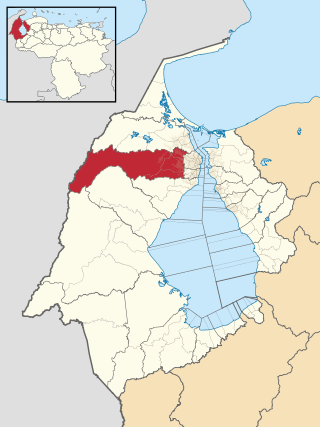
Jesús Enrique Lossada is a municipality in the metropolitan area of Maracaibo, Venezuela's second largest city. Jesús Enrique Lossada covers an area of 3,533 square kilometres (1,364 sq mi) and recorded a population of 118,756 in the 2011 Venezuelan census. It is named after Jesús Enrique Lossada (1892–1948), a distinguished lawyer, politician, professor, and writer from Maracaibo.
















